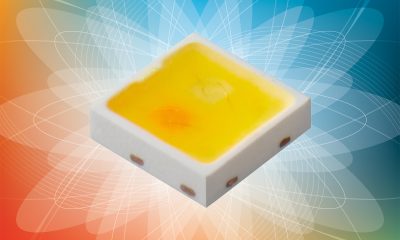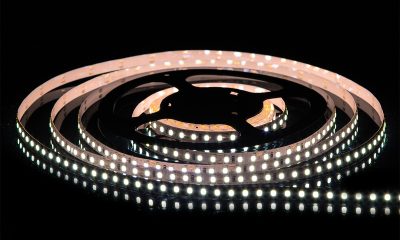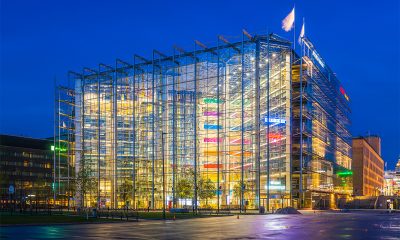What is a tunable white LED light bulb
A tunable white light bulb is a dimmable, spectrally adjustable LED lamp that can operate with a variable color temperature and lumen output. White light is a mix of many different wavelengths in the visible part of the electromagnetic spectrum. Not all white light is created equal. Different combinations of wavelengths give white light different color characteristics. A wavelength mixture laden with a higher percentage of radiant energy emitted at the long-wavelength (red) part of the spectrum has a “warm white” appearance. White light with a blue-enriched spectrum exhibits a “cool” appearance. The perceived warmth or coolness of white light is commonly communicated using a color metric known as color temperature. The concept of color temperature is based on the comparison of the apparent color of the light being produced by a source to that of an ideal blackbody radiator. The chromaticity coordinates of artificial light sources other than tungsten filament lamps typically do not lie exactly on the blackbody or Planckian locus. These light sources may be characterized as having a correlated color temperature (CCT).
The brain can interpret the warmth or coolness of white light
Color has an integral relationship with light. The warmth or coolness of white light is what our brain creates from the perceived wavelengths of light. Purely visually, it affects our visual perception and aesthetic judgement. Emotionally it defines the atmosphere and mood of a space. The color of the light source has been a staple design element in interior lighting. Whether it’s warm white, neutral white or cool white, the appearance of ambiance can transform the subjective perception of a space and impact many aspects of human experience, including relaxation, stimulation, intimacy and preference. Visually, the human visual system cannot differentiate between the different wavelengths in white light. It just captures a perceptual impression which is used by our brain to interpret the world around us and associate with a mood state. Apart from rods and cones which contribute to our vision, non-visual photoreceptors reside in retina. They transduce changes in the spectral composition and intensity of light into neural signals for the human biological clock. The direct relation between incident light of various wavelengths and photoreceptor responses can have a profound effect on human health, wellbeing and performance.
Create the dynamics in the light cycle of the solar day
Tunable white light bulbs are not simply intended for atmospheric lighting and aesthetic enhancement. They were predominantly developed to bring the dynamics in the light cycle of the solar day back to our daily lives. From the moving sun during the day to moonlight, starlight and firelight during the night, the changing spectrum and intensity of environmental light have been hardwired with the rhythmicity that drives a wide range of physiological and behavioral events in the human body. In the course of human evolution, our body has been programmed to respond to these subtle changes which thereby controls our physiological responses and psychological reactions. This continuously recurring sequence of day and night has genetically anchored itself in human biology as a system of internal clocks. This system regulates the rhythms of the body’s biological processes which can influence hormone release, body temperature, sleeping and waking cycles, metabolism, blood pressure, eating habits, glucose homeostasis, urine production and our ability to digest food. These rhythms are daily oscillations that have approximately 24-hour periods. They persist when environmental conditions (the 24-hour rhythm of the ambient changes) are kept constant.
Light is the main environmental cue influencing circadian rhythms
The endogenously generated circadian rhythms have a free-running period that is slightly greater than 24 hours. They need to be reset and synchronized with the 24-hour solar day to ensure that the behavioral and physiological rhythms are aligned with the daily rhythms in its environment. The circadian timing system is entrained to the external environment through phototransduction. Circadian phototransduction is the process of converting environmental light received by the retinal photoreceptors into neural signals for the suprachiasmatic nucleus (SCN) of the hypothalamus. The SCN is the master clock (or central pacemaker) that orchestrates the cellular circadian mechanism in peripheral organs and tissues. It not only sets the timing of peripheral clocks but also harmonizes them with each other. The main signal transducing photoreceptors are intrinsically photosensitive retinal ganglion cells (ipRGCs). The ipRGCs’ photosensitivity is driven by the protein melanopsin, which reacts only to blue light in the wavelength range of 460-480 nm. In essence, it is predominantly the blue wavelengths that deliver biological effectiveness in circadian entrainment.
As the day dawns, the proportion of biologically effective blue light is predominant in daylight. The SCN receives photic information integrated and transmitted by the ipRGCs via the retino-hypothalamic tract (RHT). The high content of bioactive blue light triggers the master biological clock to suppress melatonin secretion and stimulate the production of cortisol, dopamine and serotonin. The activation of these biological processes maximizes alertness, concentration, vitality, muscle strength and coordination to support performance, efficiency and productivity during the day. As the day progresses, the intensity and blue content in daylight declines while there is an increase in short wavelength light. The blue-depleted environmental light after sunset provides a night signal to the master clock which then commands the pineal gland to secrete melatonin into the blood, thus supporting relaxation and regeneration.
Circadian disruption can have serious consequences to health and wellbeing
In the absence of external environmental cues, the self-sustaining, endogenous oscillations generated by the SCN will be out of phase with the external environment. Since the SCN regulates the sequential and phase-relation ordering of numerous cellular oscillators in peripheral organs and tissues, synchronization of the master clock to the natural environment is critical to coordinated function throughout the human body. As we spend most of our time indoors, loss of regular and appropriate-timed optical radiation input frequently crops up. Lack of circadian entrainment due to irregular light/dark exposures or excessive exposures to blue light during the night can result in circadian disruption.
Disrupted circadian rhythms can cause the normal release of hormones such as melatonin and cortisol to be disturbed, compromise sleep quality, affect cell metabolism and proliferation, and impede the expression of clock genes associated with a vital protective mechanism that suppresses cancer and diabetes development. Disturbances to nocturnal secretion of pineal melatonin have serious consequences on our health and wellbeing. Melatonin is a hormone that plays the role of internal synchronizer of the peripheral clocks with the SCN. It is this hormone that relays physiological signals of the SCN to peripheral clocks. Melatonin is also a potent antioxidant and a direct oncostatic agent. Its disruption can lead to serious health consequences which include impaired functioning of the immune system, sleep quantity and quality, glucose metabolism, cognitive function, thyroid function, mood state, and bone density.
Tunable white LED light bulbs provide a continuously adjustable range of color temperatures at any intensity to ensure that the circadian system remains entrained or synchronized to the 24-hour light/dark cycle of the external environment. Tunable white lighting is the enabling technology of human centric lighting (HCL).
Also known as referred to as biodynamic lighting or circadian lighting, HCL is intended to support the health, wellbeing and performance of humans by simulating the changing color and intensity of natural light over the entire day. Tunable white LED light bulbs enable the creation of scenes and modes that are aligned with the cyclic biological processes. This ability is achieved by capitalizing on characteristics unique to LED technology. Unlike incandescent and compact fluorescent lamps which emit a static spectrum of light, LEDs deliver superior dimmability and wavelength customizability in a compact footprint to enable additive color mixing in lamps and luminaires. These semiconductor emitters can be readily paired with control circuits which run color mixing algorithms to produce precisely controllable colors. Adding network connectivity to the intelligent lights enables interaction with mobile devices and cloud platforms that allow to reap the power of the Internet of Things (IoT).
Hardwire circadian rhythms through tunable white lighting
A tunable white LED bulb is a multi-channel LED system that produces an intended spectrum of light by mixing at least two LED primaries. The spectrally tunable light may be designed as an RGBW, RGBA or RGBWA system that provides a broad gamut for CCT tuning across the entire range of the Kelvin scale. But nevertheless, the use of phosphor-converted white LEDs as the component LEDs of a tunable white system is a more common choice due to cost considerations. Tunable white LED lamps may be a 2-channel system that mixes warm white LEDs and cool white LEDs to call up a CCT anywhere in between chromaticity points of each LED primary.
Mixing only two LED primaries ends up with a linear range of color temperatures and results in the deviation of chromaticity coordinates from the Planckian locus. This deviation from the Planckian locus or the distance above or below from the Planckian locus becomes larger with a wider range of possible CCTs, e.g., 2700K-6500K, and causes the white light in the middle of the mixing range to have a green or pink tint. Adding one or more primaries to the warm and cool white LEDs makes it possible to control the chromaticity coordinates for minimal deviation from the Planckian locus. Typically, the component LEDs of a color mixing system designed for use in a light bulb are discrete SMD LEDs. There are other forms of color mixing packages or assemblies, including the chip-on-glass (COG) LED filaments that can approximate the appearance of a tungsten filament.
Intelligent color mixing
At its core, tunable white lighting is about dimming and control. Without accurate dimming and flexible control of the individual LED channels, the color mixing system would lose its tunability. To produce a predictable CCT, the ratios of the constituent colors must be tightly controlled and the component LEDs must be dimmed to provide a precise amount of light. Dimming of the LEDs may be accomplished through pulse-width modulation (PWM) and constant current reduction (CCR). CCR or analog dimming is a more straightforward and cost-effective solution but it suffers from color shift, limited dimming range and steps of color depth. PWM supports full range digital dimming and maintains color stability over the full dimming range, although it’s more complex and expensive to implement.
Tunable white LED light bulbs are smart devices that have embedded programmability and wireless network connectivity. The multi-channel LED driver reacts to commands issued by a microcontroller which connects an IP-enabled device or cloud platform via a wireless protocol such as ZigBee, Wi-Fi or Bluetooth. CCT tuning and scene programming are made through a mobile app that run on a smartphone or tablet.



















Loading...